Abstract
Background:
Vermicomposting convert waste to wealth in a safe and healthy way, because it is done by biopotential of earthworm. Vermicompst is a good organic fertilizer that decreases environmental pollution. It contains plant growth hormones, enzymes, microbial population, and free of small animals and harmful pathogens such as Salmonella. Application of such a microbiologically active organic substrate may have important effects on the microbial properties of the media.Objectives:
This study was conducted to investigate the effect of different amounts of vermicompost and cow manure on germination, growth, and yield of tomato plant, and compare them at the greenhouse of Mashhad Municipality compost plant under field conditions in 2012.Materials and Methods:
This study was laid out in a randomized complete block design with factorial arrangement and 4 replications for each treatment. In the present study, vermicompost and cow manure were evaluated in four different dosages (250, 375, 500, and 625 g/m2 mixed with soil).Results:
The analysis of the variance results revealed that the effect of the type and amount of fertilizers on tomato yield was significant at 1% level. The results of this study showed that using the vermicompost dosage to cow manure of 500 g/m2 could significantly increase the tomato yield.Conclusions:
The vermicompost as a potential source of plant nutrients for sustainable tomato production can reduce health and environmental problems.Keywords
1. Background
With growth and development of the communities, the amount of urban solid waste increases, which is nowadays considered one of the serious problems for humans’ life; because increasing use of chemical fertilizers and pesticides in agricultural ecosystems have created numerous and important problems such as food chain disruption, destruction of soil resources, and resistance of pests to pesticides. Organic fertilizer production and application and the use of biological control methods aid in solving many agriculture problems. Among available methods, using an appropriate one like composting organic materials for biological fertilizer production has been welcomed extensively (1).
One of the best techniques for composting is vermicompost, by using a suitable earthworm species like Eisenia fetida. Vermicompost is the waste of worms feeding from solid waste, plant waste, and such additives as manures (2, 3). Vermicompost is a nutrient-rich, microbiologically-active organic amendment that results from the interactions between earthworms and microorganisms during the breakdown of the organic matter. It is a stabilized, finely divided peat-like material with a low C:N ratio, high porosity, and high water-holding capacity, in which most nutrients are present in forms that are readily taken up by plants. The most important benefit of vermicompost is its diverse and high microbial population. Its other benefits are as follows: good organic fertilizer, decreasing environmental pollution, and detoxifying some toxic chemicals. Recently, using vermicompost has increased because of these benefits and many researches are carried out to optimize them (4). Waste of worms often contains nitrogen, phosphorus and potassium 5 to 11 times more than the bare soil (5).
Tomato is an annual plant with a special importance owning to its extensive industrial and edible uses. Tomato is used in different ways: freshly used in salad; in the caterings; or in the food processing plants for producing canned pickles, sauce, juice, flour, and most importantly tomato sauce. This plant is of considerable importance in industry because of its role in employment and added value. Its economic importance is being augmented day by day so that many farmers have allocated a large part of their farms for cultivation and nurturing of this important plant (6). In a study, the effects of different ratios of compost produced from municipal solid waste were evaluated regarding their physical and chemical characteristics as well as level of heavy metals in soil and tomato organs. It showed that the presence of compost led to an enhancement in pH, electrical conductivity, and density of growth medium in soil and amount of heavy metals in plant and soil (7, 8). Investigating the effect of vermicompost and phosphorus on morphological properties of tomato seedling (length of the internode, amount of chlorophyll, leaves area and dry weight of the shoots and roots) and absorption rate of nitrogen, phosphorus and potassium, revealed that all the mentioned parameters were significantly influenced by the vermicompost. The characteristics such as length of the internode, leaf area index (LAI), dry weight of root, and absorption of macroelements were significantly affected by the interaction of vermicompost and phosphorus which was not significant for other elements (9, 10). In all cases, application of biological fertilizers increases the absorption rate of these elements compared with the control group. In most cases, the best results were obtained using the vermicompost (11, 12).
2. Objectives
This study was conducted to investigate the effect of different concentrations of vermicompost and cow manure on germination, growth, and yield of tomato plant.
3. Materials and Methods
In order to evaluate the vermicompost fertilizer and animal manures efficiency on arboreal tomato product and to compare these two fertilizers, an experiment was designed with 3 treatments; each of them was repeated 4 times and performed in the greenhouse of organic fertilizer factory of Mashhad in February 2012. The factors of this study were as follows: 2 types of fertilizers containing vermicompost and cow manure (F1 and F2 respectively), and 4 different concentrations of fertilizers: 250, 375, 500, and 625 g/m² (q1, q2, q3, and q4 respectively). At first, vermicompost with the above ratios, was mixed with soil on plots with an area of 1 m² and at a depth of 15 cm; on the opposite side manure was mixed with soil with the same ratios, plots, and depth. Before performing the experiment, both types of the fertilizers were chemically analyzed in the laboratory of the Mashhad compost factory. In each plot, two seeds of arboreal tomato were cultivated, being separated from each other with a distance of 30 cm. All the intervening factors, including irrigation, temperature, moisture, light, combating pests, diseases, and weeds were similar for all the treatments during the germination period.
The temperature range and relative humidity of the greenhouse was maintained at 18°-29°C and 70%, respectively, for pollination of the plants. During fruiting of the plants, with the aim of preserving healthy and high quality fruits, the small and malformed fruits were removed and only 4 to 5 of the best fruits were preserved. During the experiment, no other fertilizer was applied as nutritional supplement in order to examine the effect of the used fertilizers. For fighting against mildew disease of tomato, the infected leaves were removed. To fight off the weeds, hand weeding was performed. Cultivation of the plants was done early in March. The first harvest of the plants (the ones consuming the cow manure) was conducted on 30th April 2012. Data were analyzed by SPSS software and variance analysis. A P value < 0.01 was considered statistically significant.
4. Results
Table 1 summarized the results of chemical analysis of the field soil, vermicompost, and cow manure used in study. Table 2 summarized the results of the variance analysis of the tomato yield. As it is observed, the effect of fertilizer type and amount was significant at 1% level. In the present study, harvesting the plants was carried out in 3 stages and the yield of each plant for every fertilizer treatment was weighed discretely. In the first harvest, yield of the plant fed with manure was more than yield of the plants fed with vermicompost, which is most likely related to increasing plant photosynthesis. In the second and third harvest, yield of the plants treated with vermicompost was more than yield of the plants treated with the manure. Figure 1 illustrates the yield of each plant (kg) in different harvests.
As it is observed, in the treated plant with manure, the first harvest growth rate relative to the second harvest was 39.96% and the second harvest relative to the third one was 6.85%, while in the treated plants with vermicompost, the growth rate of the first harvest relative to the second one was 62.74%, and the second harvest relative to the third one was 12.71%. Alteration of the physical properties of soil and the ability of the plant to have access to the nutrients may be possible reasons for the observed increase in the function and growth of the plants treated with vermicompost. Figure 2 illustrates the amount of yield of each plant in the presence of different dosages of fertilizer. Figure 3 illustrates the yield rate of the plants fed with 4 different dosages of fertilizers in the first harvest.
In the second and third harvest, as time passed and a large part of the stabilized nutrients in the fertilizers were released and consumed by the plants, the yield rate showed an increase, which was equal in both treatments in fertilizer dosages of 250 and 375 g/m2 and were in defined range. Figure 4 and 5 illustrate the yield rate of the plants fed with 4 different dosages of fertilizers in the second and third harvest. Increase in total yield of tomato can be ascribed to the improvement of soil nutrients and, to some extent, improvement in the quality of soil structure following application of vermicompost. Figure 6 shows the total yield rate.
| Factors | Field Soil | Vermicompost | Cow Manure |
|---|---|---|---|
| Humidity, % | 50 | 54 | 55.2 |
| pH | 7.7 | 7.49 | 7.66 |
| EC, ms/cm | 1.18 | 1.48 | 0.7 |
| Organic carbon | 59 | 45.2 | 36.9 |
| TVS, % | 15 | 21 | 81.9 |
| N | 1.1 | 1.32 | 1.4 |
| K | 1 | 1.3 | 0.9 |
| Na | 0.5 | 0.8 | 0.4 |
| C: N ratio | 13.6 | 15.9 | 26.3 |
The Results of Variance Analysis of Yield of Greenhouse Tomatoes (kg/m2)
| Source | Degree of freedom | The First Harvest | The Second Harvest | The Third Harvest | Total Yield, kg.m2 |
|---|---|---|---|---|---|
| Block (replication) | 2 | 100.416 | 13.625 a | 17.9166b | 61.125 a |
| Type of fertilizer (A) | 1 | 26.666 b | 15.0416 a | 22.04166 a | 48.1666 a |
| Amount of fertilizer (B) | 3 | 18.055 a | 11.8597 a | 73.375 a | 54.8555 a |
| A × B | 3 | 500.0 b | 28.194 b | 15.2777 | 27.7787 |
| Error | 14 | 24.22 | 12.9166 | 15.5357 | 46.4880 |
Yield Rate of Tomato Plant in Three Harvesting Stages
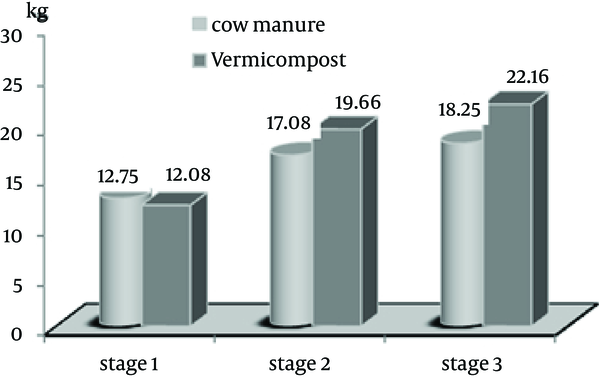
Yield Rate of One Plant After Treatment With Two Different Fertilizers
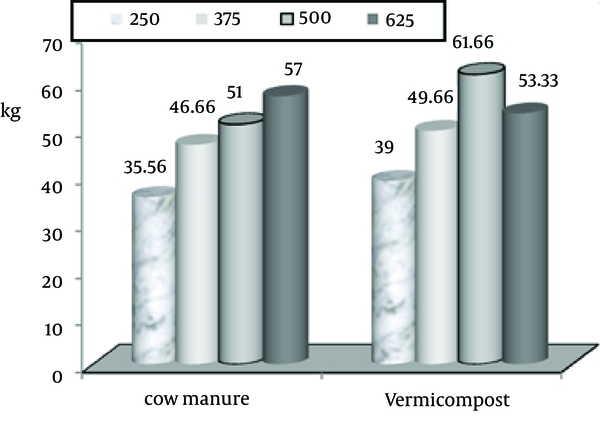
Yield Rate of the Plants at First Harvest Stage
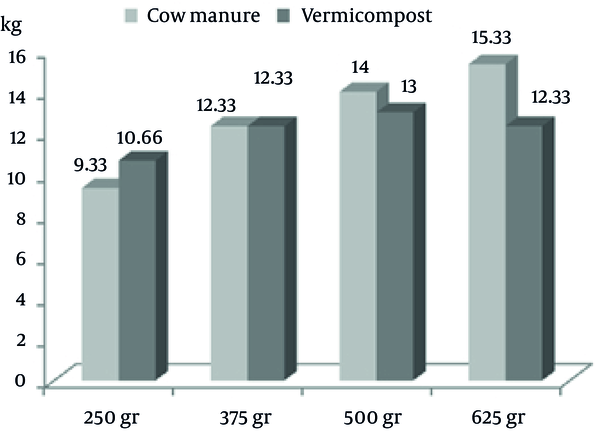
Yield Rate of the Plants in the Second Harvest Stage
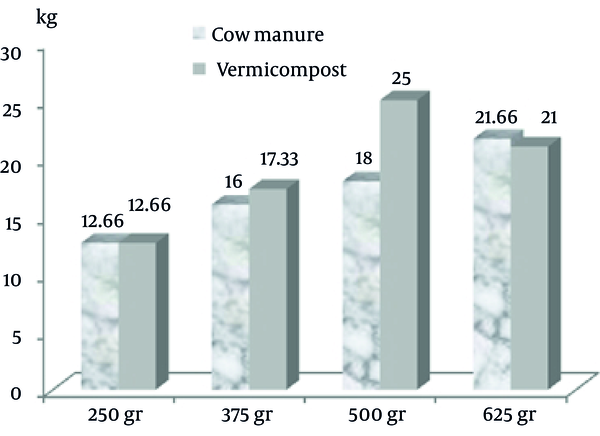
Yield Rate of the Plants in the Third Harvest Stage
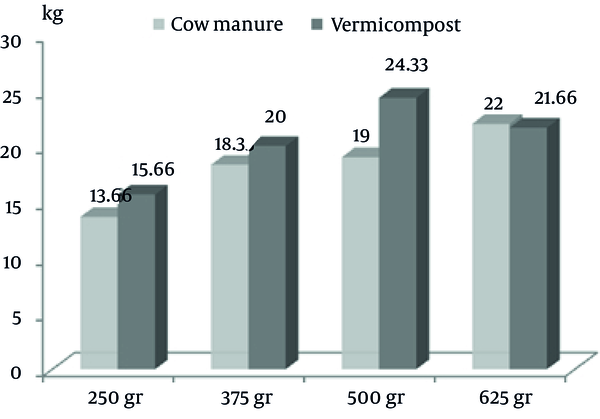
Total Yield Rate Tomato in Application Two Different Fertilizers
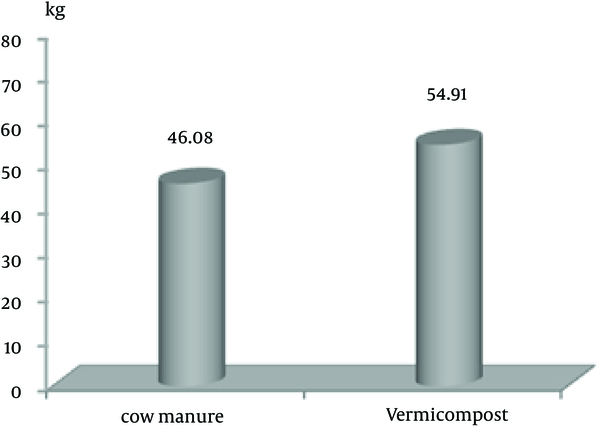
5. Discussion
Among the physical properties of vermicompost, water absorption is of high importance. Therefore, the more moisture, ventilation, and presence of nutrients, the better yields the plant can have. Yield of the plants fed with vermicompost dosages of 500 g/m2 increased, which may be the result of higher absorption of the nutrients and better feeding of the plant. It seems that earthworms have a role in enhancement of the solubility of the mineral iron or its maintenance in absorbable form in the fertilizer and contribute to the production of vermicompost (3, 5). Vermicompost can reduce health and environmental problems. Vermicompost has detoxifying ability, thus its cultivation products are safe. Also, vermicompost is safe for farmers (4). In this regard, yield of the plants treated with cow manure dosage of 500 g/m2 decreased, which is probably due to its high pH relative to the vermicompost fertilizer. The reason is that the absorption of ferrous and zinc metals by the plant decreases when the pH increases to 0.3.
The increase in product of the plants treated with manure was regularly maintained, but in the treated plants with vermicompost a reverse outcome was observed and the product of the plants decreased using the fertilizer dosage of 625 g/m2. It may be due to an increase in the concentration of the elements dissolved in the soil after using 625 g vermicompost, which leads to a reduction in activity of microorganisms of soil and affects the absorption rate of micronutrients by the plant (13).
Hence, the results of the present study show that vermicompost dosage of 500 g/m2 can significantly increase the product of tomato plants. The results are in consistent with the results of Najar and Khan which was 600 g/m2. This study suggests that the vermicompost is a potential source of plant nutrients for sustainable tomato production (1, 14).
Acknowledgements
References
-
1.
Najar IA, Khan AB. Effect of Vermicompost on Growth and Productivity of Tomato Under Field Conditions. Acta Biologica Malaysiana. 2013;2(1):12-21.
-
2.
Alidadi H, Najafpoor AA, Vafaee A, Parvaresh A, Peiravi R. Biodegradation of Lignocelluloses in Sewage Sludge Composting and Vermicomposting. Arch Hyg Sci. 2012;1(1).
-
3.
Alidadi H, Saffari AR, Peiravi R. Effects of Biofertilizers Effects of Compost, Vermicompost and Sulfur Compost on Yield of Saffron. World Appl Sci J. 2013;21(9):1386-90.
-
4.
Sheela S, Khimiya S. Vermicompost to save our agricultural land. Res J Agr Forest Sci. 2013;1(4):18-20.
-
5.
Chauhan A, Kumar S, Gupta M. Vermicomposting of Vegetable Wastes with Cowdung Using Three Earthworm Species Eisenia foetida, Eudrilus eugeniae and Perionyx excavatus. Nat Sci. 2010;8(1):33-43.
-
6.
Joshi R, Vig AP. Effect of vermicompost on growth, yield and quality of tomato (Lycopersicum esculentum L). Afr J Basic Appl Sci. 2010;2(3-4):117-23.
-
7.
Arancon NQ, Edwards CA, Babenko A, Cannon J, Galvis P, Metzger JD. Influences of vermicomposts, produced by earthworms and microorganisms from cattle manure, food waste and paper waste, on the germination, growth and flowering of petunias in the greenhouse. Appl Soil Ecol. 2008;39(1):91-9. https://doi.org/10.1016/j.apsoil.2007.11.010.
-
8.
Suthar S. Nutrient changes and biodynamics of epigeic earthworm Perionyx excavatus (Perrier) during recycling of some agriculture wastes. Bioresour Technol. 2007;98(8):1608-14. [PubMed ID: 16901690]. https://doi.org/10.1016/j.biortech.2006.06.001.
-
9.
Bachman GR, Metzger JD. Growth of bedding plants in commercial potting substrate amended with vermicompost. Bioresour Technol. 2008;99(8):3155-61. [PubMed ID: 17689243]. https://doi.org/10.1016/j.biortech.2007.05.069.
-
10.
Reséndez AM, Aguilar FJL, Viramontes UF, Dimas NR, Arroyo JV, Carrillo JLR, et al. Tomato production in sand: vermicompost mixtures compared with sand and nutritive solution. J. Agric. Sci. Rev. 2012;1(1):19-26.
-
11.
Meenakumari TSM. Vermicompost and other fertilizers effect on growth, yield and nutritional status of tomato plant. World Res J Agr Biotech. 2012;1(1):14-6.
-
12.
Sahni S, Sarma BK, Singh DP, Singh HB, Singh KP. Vermicompost enhances performance of plant growth-promoting rhizobacteria in Cicer arietinum rhizosphere against Sclerotium rolfsii. Crop Prot. 2008;27(3-5):369-76. https://doi.org/10.1016/j.cropro.2007.07.001.
-
13.
Nath G, Singh KP. Combination of vermicomposts and biopesticides against nematode and their effect growth and yield of tomato (Lycopersicon esculentum). IIOAB Journal. 2011;2(5):27–35.
-
14.
Kavroulakis N, Ehaliotis C, Ntougias S, Zervakis GI, Papadopoulou KK. Local and systemic resistance against fungal pathogens of tomato plants elicited by a compost derived from agricultural residues. Physiol Mol Plant P. 2005;66(5):163-74. https://doi.org/10.1016/j.pmpp.2005.06.003.